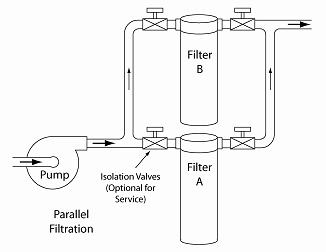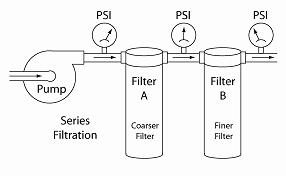At first glance, plumbing a filter into a system doesn’t sound like a big deal. In fact, it really isn’t, but there are right ways and wrong ways to do it. Here are a few ideas.
First, liquids should always be PUSHED, not PULLED through a filter. Most pumps used in industrial and precision cleaning systems are not designed to pull suction on a supply, at least not in the normal course of things. The rare exception is, for example, a “Y” strainer is used prior to a pump to protect that pump from large things that might cause it damage. Things like nuts, bolts and whatever, that might find their way into the intake to the pump. “Y” strainers offer very little resistance to flow. Liquids will usually pass through them by the force of gravity alone. General rule – always position the filter after the pump.
Positioning the filter inlet and outlet (both if they are at different levels) at an elevation above the liquid level in tank it services allows filter maintenance without draining the tank. If it is not possible or is inconvenient to elevate the filter as described, isolation valves should be provided to facilitate servicing without draining the tank to save time and expensive chemistry. Some filters provide a bottom drain to drain the filter housing before it is opened to replace the media.

In some cases, the use of more than one filter makes sense. Filters can be plumbed in series or in parallel as shown. This arrangement is often called “duplex” filtration. Plumbing filters in parallel increases the flow capacity and reduces the pressure drop across the two combined filters. This arrangement should be used in cases where a large volume of contaminating solids is present. With isolation valves added on the inlet and outlet of each filter, the filters can be serviced (one at a time) without down time. Only the filter being serviced is off line.

Plumbing filters in series makes sense in some cases. Two filters of different ratings are often arranged so that the first filter in line removes the bulk of the larger particles thereby extending the life of the second filter which is chosen to filter out smaller particles. Filters to remove smaller particles are often more costly (and don’t last as long) as coarser filters. The use of two filters in series, of course, increases the pressure drop across the two in combination and may require a pump with larger capacity.
As stated above, filters arranged in series makes sense in some cases but not all. Based on a study of the particle size distribution, the first filter should be of a type chosen to capture only the larger particles allowing smaller ones to pass. Otherwise, the first filter in line will, as it ages, be capturing smaller and smaller particles which will cause it to require replacement prematurely. Means to monitor the differential pressure across both filters is recommended to help prevent the unnecessary replacement of both filters as a matter of course when, in fact, only one needs replacing.
Proper plumbing is important to the overall effectiveness of a filtration system. A little effort in the beginning may save a lot of hassle for maintenance and process technicians.



 English
English Spanish
Spanish Chinese
Chinese Canada
Canada Mexico
Mexico United Kingdom
United Kingdom



